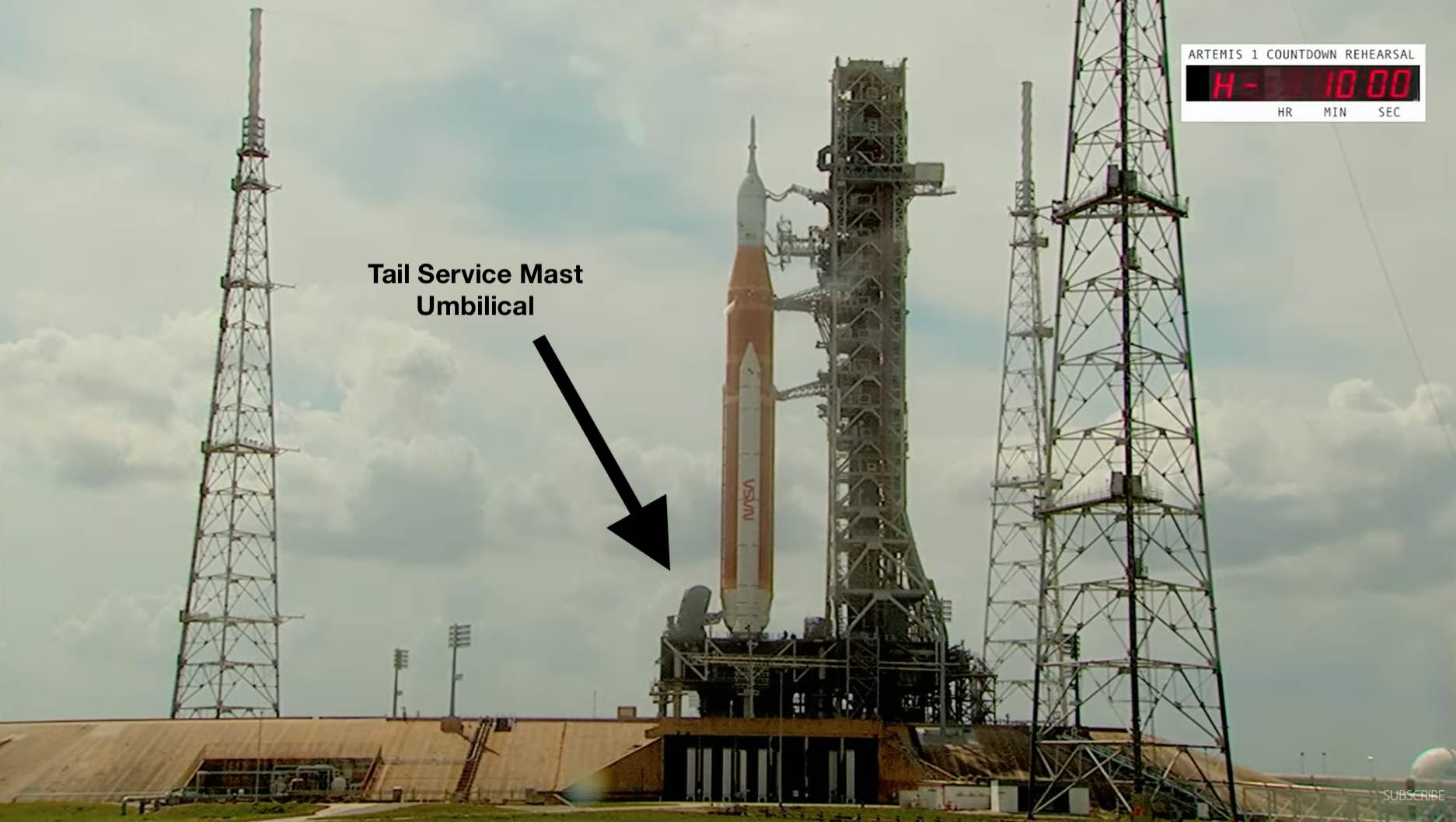
A hydrogen leak near the connection between NASA’s Space Launch System moon rocket and its mobile launch platform foiled another attempt Thursday to pump cryogenic propellants into the towering mega-booster at the Kennedy Space Center.
NASA managers called off a countdown rehearsal Thursday afternoon after hours of delays stemming from at least four technical problems. The final, and potentially most significant, issue was a hydrogen leak in the tail service mast umbilical on the mobile launch platform near the bottom of the SLS core stage.
Engineers discovered the leak during operations Thursday to load liquid hydrogen into the core stage on Launch Complex 39B at NASA’s Kennedy Space Center. The leak forced managers to stop the propellant loading with the core stage’s liquid hydrogen tank 5% full and the liquid oxygen tank at the 49% level, according to NASA.
The tail service mast umbilical routes super-cold propellants from the mobile launch platform into the rocket’s 27.6-foot-wide (8.4-meter) main stage.
The launch team planned to drain the propellants from the SLS core stage Thursday evening, allowing technicians to return to pad 39B to inspect the leaky umbilical connection, review data, and determine what to do next to address the problem, NASA said.
“Hydrogen is extremely hazardous, cold, and a small molecule that is known for leaking,” tweeted Jeremy Parsons, deputy manager of NASA’s exploration ground systems program at Kennedy. “All of these systems have been sealed, leak checked and tested to the highest extent possible prior to wet dress rehearsal.”
But the leak checks between the SLS core stage and the mobile launch platform have, until recent fueling tests, all occurred at warm ambient temperatures. Liquid hydrogen fuel is chilled to minus 423 degrees Fahrenheit (minus 253 degrees Celsius), and liquid oxygen is stored at minus 297 degrees Fahrenheit (minus 183 degrees Celsius).
At those temperatures, valves, seals, and gaskets can contract and change shape, revealing a leak that wasn’t apparent in warmer conditions. Hydrogen can find its way through seals that would contain other molecules.
“Under the unique operating conditions with the rocket, we are prepared and know leaks are a realistic possibility,” Parsons tweeted Thursday. “We have amazing hazardous gas and leak detection systems that keep the rocket safe and alert us to conditions outside of normal parameters.”
NASA said the leak discovered Thursday is located in an area called the “purge can” on the exterior of the tail service mast umbilical. The purge can is attached to the umbilical plate, which would retract into the structure’s protective housing at liftoff.
The purge can area is accessible to technicians while the rocket is at the launch pad, giving hope for NASA officials that the leak could be repaired without moving the Space Launch System back to the Vehicle Assembly Building.
Hydrogen leaks have cropped up in other rocket programs. NASA engineers spent months tracing hydrogen leaks that kept NASA’s space shuttles grounded in 1990.
“Having lived through ‘the summer of hydrogen leaks’ on the shuttle I can sympathize,” tweeted Wayne Hale, a former NASA flight director and former manager of the space shuttle program. “And that was after 35 or so launches. A leak the first time is almost to be expected. But not satisfactory.”

NASA’s launch team discovered the hydrogen leak after overcoming several other issues Friday, including an outage in the gaseous nitrogen supply to pad 39B, an issue with the temperature of liquid oxygen, and a pressure surge detected when engineers initially tried loading hydrogen into the core stage.
The countdown test Thursday followed two previous tries April 3 and April 4 to fully load the Space Launch System with super-cold liquid hydrogen and liquid oxygen, a key checkout known as a wet dress rehearsal. Those attempts were thwarted by problems with ground supply fans at pad 39B and a manual valve on the launch tower left in the wrong position when ground crews left the pad.
NASA rolled the 322-foot-tall (98-meter) moon rocket from the Vehicle Assembly Building to pad 39B on March 17, revealing the fully stacked rocket for the first time. Once NASA manages are satisfied they have met the objectives of the wet dress rehearsal, teams will transfer the rocket back to the VAB for inspections and final outfitting for launch.
NASA officials hoped to launch the moon rocket on the Artemis 1 mission as soon as early June, but that was before the countdown test encountered delays. The rocket will launch an unpiloted Orion crew capsule around the moon on a test flight before NASA puts astronauts on the second SLS/Orion mission. The Artemis program aims to return astronauts to the moon later this decade.
Going into Thursday’s practice countdown, NASA managers already decided to forego loading cryogenic propellants into the upper stage of the Space Launch System. Engineers couldn’t tank that element of the rocket, made by United Launch Alliance, due to a failed helium valve.
The core stage, built by Boeing, contains the majority of the cryogenic propellants used by the rocket.
As part of Thursday’s test countdown, the NASA launch team at Kennedy flowed small amounts of cryogenic propellant up the transfer lines on the mobile launch tower to the connection with the upper stage tanks. The operation “chilled down” the propellant lines, allowing engineers to verify their readiness for launch day, but did not flow propellants into the upper stage tanks.
Email the author.
Follow Stephen Clark on Twitter: @StephenClark1.
from Spaceflight Now https://ift.tt/iPuAWoh
via World Space Info







0 comments:
Post a Comment